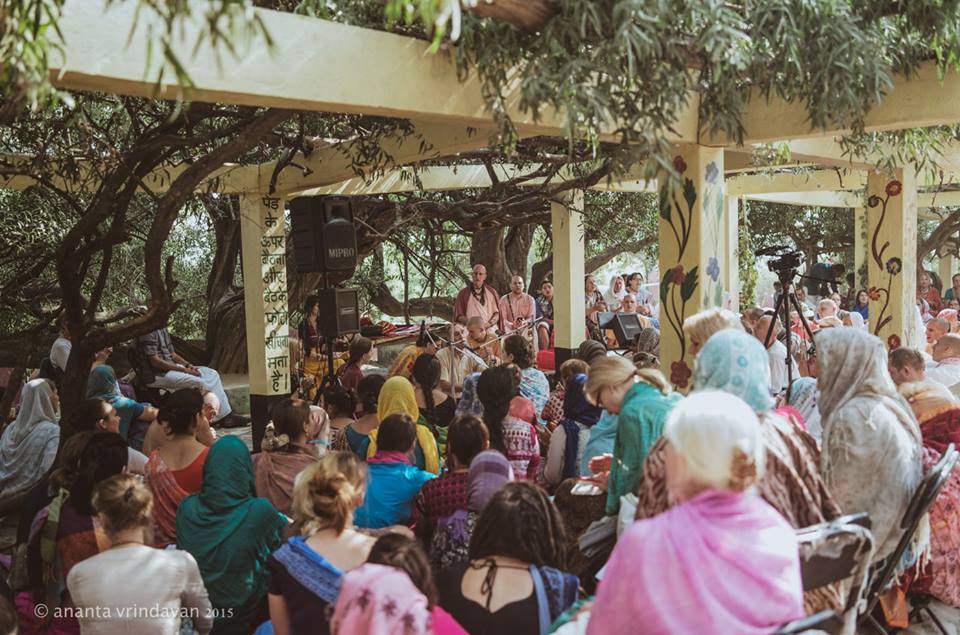
Tera Kadamba – HG Baḍa Haridāsa Prabhu – Preface, Indradyumna Swami’s Parikrama -2015
Preface to Śad-Gosvāmī Aśtaka
– By HG Baḍa Haridāsa Prabhu
Hare Kṛṣṇa,
We are here at the very beautiful Tera Kadamba, where Śrīla Rūpa Gosvāmī wrote Bhakti-Rasāmṛta-Sindhu. Many wonderful pastimes happened here. We will hear more about those from Śītalā Devī. We want to sing these beautiful prayers to the six-Gosvāmīs, by Śrīnivas Ācārya! Anyone of you familiar with these prayers? Not so many. Okay, actually Śrīla Prabhupāda one time said, “By studying these prayers we can understand the internal mood of the Spiritual Master.” These are in Sanskrit, they are pretty long, but it’s not too hard to follow. You will probably recognize some of the words. We won’t go through all of the translations. We are going to give you just a little bit of an idea.
It begins: kṛṣṇotkīrtana, so this is actually three words: kṛṣṇa, uta, kīrtana. These Gosvāmīsare the greatest scholars that had ever lived. They were not dry scholars. They were loudly chanting the names of Kṛṣṇa; so ‘kṛṣṇotkīrtana gāna’—and they are singing and dancing— ‘nartana’; and ‘premāmṛtāmbho-nidhī’—they are just like an ocean of love of God, of Prema. Then ‘dhīrā and adhīra-jana’—dhīrā means sober or what you could say saintly people; and adhīra—just the opposite, strongly stated here is ruffians. Like the people you meet at Woodstock, they are in the adhīra category [laughter]. But even to these people ‘priyau’—the Gosvāmīs are very dear even to such people. That’s the nature of saintly people, that even kind of rough characters liked them. Why is that? ‘nirmatsarau’because they are not envious of anyone.
They were all trying to eradicate from the hearts the disease in the material world, which is envy. Saintly persons are free from this envy and so naturally everyone loves them. One time the devotees told Śrīla Prabhupāda, ”Śrīla Prabhupāda, everyone loves you,” and he said, “Yes, because I love everyone.”
Next ‘śrī-caitanya-kṛpā-bharau’—they are carrying a huge burden. What is that burden?‘śrī-caitanya-kṛpā’—it means the mercy of Lord Caitanya. Are you familiar with that word—‘kṛpā’? Then ‘bhārāvahantārakau’—they are pleasing to everyone. They are fully blessed by Lord Caitanya.
Therefore, each line after glorifying the Gosvāmīs in various ways; the last line is concluded with ‘vande rūpa’—my obeisances to Rūpa Gosvāmī, ‘sanātanau’—unto Sanātana Gosvāmī, ‘raghu-yugau’—the two Raghus, meaning Raghunātha Dāsa Gosvāmīand Raghunātha Bhaṭṭa Gosvāmī, ‘śrī-jīva’—Jīva Gosvāmī, and ‘gopālakau’— GopālaBhaṭṭa Gosvāmī. So we can sing this line together:
vande rūpa-sanātanau raghu-yugau śrī-jīva-gopālakau
[Everyone in Chorus]:
vande rūpa-sanātanau raghu-yugau śrī-jīva-gopālakau
Hey, I think you know the tune already, but let’s do one more verse quickly.
Next ‘nānā-śāstra’—so what does śāstra mean? You’ve heard that word, right? Śāstra means scriptures, so ‘nānā-śāstra-vicāraṇaika-nipuṇau’—they are singularly expert, extremely expert at studying the scriptures.
Then ‘sad-dharma-saṁsthāpakau’—and they were ordered to establish ‘sad-dharma’ or true religion. They are ‘lokānāṁ hita-kāriṇau’—that means the well-wishers of the whole universe; and ‘mānyau śaraṇyākarau’—they are worthy of taking shelter of. Actually Prabhupāda said, “We are Rūpānugās”; so they are our shelter, especially Rūpa Gosvāmī.
Next: ‘rādhā-kṛṣṇa-padāravinda-bhajanānandena mattālikau’—they are always absorbed, just like mad in love for Rādhā and Kṛṣṇa.
Again I ask you, as we sing these songs try to kind of look at the translations, and understand what we are saying and connect to the feelings and then glorification which has been given here. This is a wonderful place to pray for the mercy of Śrīla Rūpā Gosvāmī.
[Kīrtana: Śrī-Śrī Ṣaḍ-Goswāmi-Aṣṭaka]